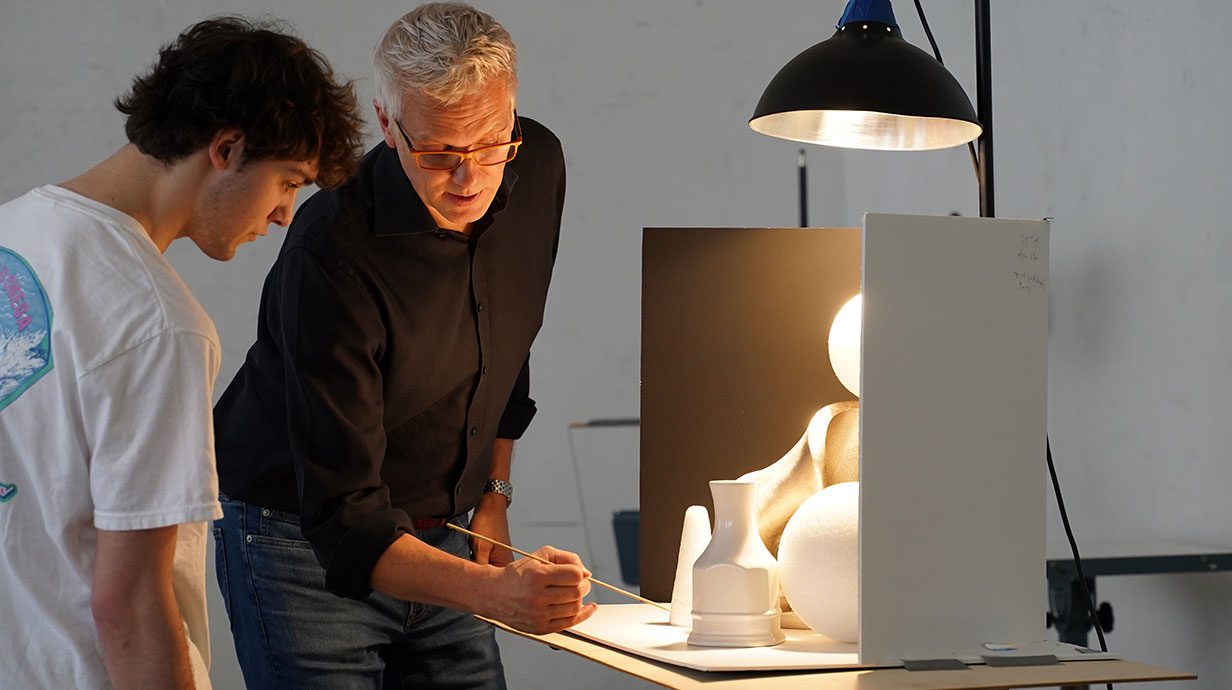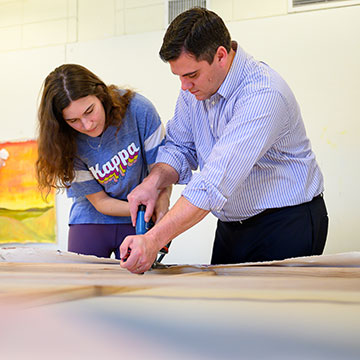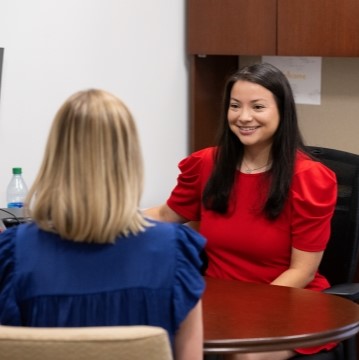Resources & Scholarships in Art & Art History
We are committed to student success by providing a variety of support and resources to achieve your goals.

The Tools for Success
Find out about the generous scholarship opportunities for art and art history students and student success resources available at the department, college, and university levels.
Undergraduate Scholarships
Find out if you're eligible for scholarships and learn how to apply.
Eligibility
- Full-time student
- Art or art history major
- Active member of Kappa Pi International Art Honor Society
Application
- Complete the application on the Kappa Pi website.
Kappa Pi International Art Honor Society, which was founded in 1911 at the University of Kentucky, offers scholarships ranging from $250 to $1,000 that are awarded nationally from a total of $10,000 annually available for awards. For additional information please contact art@olemiss.edu.
Eligibility
- Entering freshman
- Participation in the Mid-South Art Awards at the Brooks Museum in Memphis while in high school
- Major in art or art history
Application
- Department faculty member will meet with students during the Mid-South Art Awards event
- Portfolio review process juried by department faculty
Art or art history majors who participated in the Mid-South Art Awards at the Brooks Museum in Memphis are eligible to be considered for a $500 scholarship + a partial waiver of non-resident fees (for out-of-state students). A faculty member from the Department of Art & Art History will meet with students on the day of the event, and a student will be chosen through a portfolio review process juried by art and art history faculty members.
For additional information please contact Professor Philip Jackson in the Department of Art & Art History and visit Mid-South Scholastic Art Awards.
Eligibility
- Full-time student
- Major in Art
Application
- No application required
About Patricia S. Hopson
This scholarship was established in 2005 by Dr. W. Briggs Hopson, Jr. of Vicksburg, Mississippi, to honor his wife, Patricia S. Hopson.
Eligibility
- Full-time student
- Major in art, emphasis in printmaking
Application
- No application process
About Roy Frank Finger
Mr. and Mrs. Wade Finger, formerly of Tupelo, Mississippi, established this scholarship in 1996 in
memory of their son, Roy Frank Finger. Roy completed his MFA in printmaking at the University of
Mississippi in 1975 and soon after was killed in an automobile accident.
Eligibility
- Full-time student
- Major in art, emphasis in Ceramics
Application
- No application process. Selection by ceramics studio faculty.
About Sean Manning
Self-taught artist and philanthropist Richard Sean Manning, a native of Lockport, New York, is a prolific artist who works in many mediums. He started his art career as a ceramic artist and throws up to five tons of clay each year to create ceramic art. Over the years he has been guided by several ceramics professors including UM art professor Matt Long, where Sean’s relationship with UM originated. His ceramic work "9/11 Memorial Towers" is in the permanent collection at the National September 11 Memorial Museum in New York. Sean Manning donates much of his work to worthy causes, which inspired him to set up his own charitable organization.
Eligibility
- Full-time student
- Entering freshman
- First preference to art majors
Application
- Application and Selection by Ole Miss Women's Council for Philanthropy
About Susan Barksdale Howorth
Susan Barksdale Howorth of Oxford had decided to pursue a master’s degree in art when her life was cut short. Her great interests and passions in both creating art and providing educational opportunities for others will live on through University of Mississippi students who receive scholarships in her name. The scholarship was created by a gift from her husband, Circuit Court Judge Andrew K. Howorth of Oxford, as well as memorials from family and friends.
Eligibility
- Full-time student
- Entering freshman
- Mississippi resident
- First preference for those who study painting or sculpture
Application
- Apply for Art Merit Scholarship
About William Hollingsworth, Jr.
This full-tuition scholarship is named for William Hollingsworth, Jr., a prominent young artist in the 1930s and early '40s whose career was cut short by his suicide in 1944. He attended UM from 1928 to 1930 then studied at the Art Institute of Chicago (1930–1934). Hollingsworth returned to his native Mississippi where he produced a large number of watercolors and oil paintings shown at exhibitions throughout the country. Inspired by French impressionist painters, he also painted the Mississippi landscape, sunsets, and sunrises, and won numerous prizes for his painting of his hometown Jackson, MS. Read this article from the Mississippi Department of Archives and History.
Art Merit Scholarship
Find out if you're eligible and learn how to apply.
- vary in an amount up to $3,000 for 8 consecutive semesters (not including summer).
- are for incoming freshmen and transfer students pursing a bachelor’s degree in art or art history at the University of Mississippi.
- are for MS residents and non-MS residents. Non-resident recipients will be granted a $2,000 scholarship toward the non-resident fee per year.
- are competitive and will be judged through a blind jury process of faculty members.
Studio art applicants submit a digital portfolio with 10 to 15 pieces of their best work. Art History applicants submit a digital writing sample of three to five pages. Applicants for the Art Merit scholarships are automatically considered for the Hollingsworth Scholarship.
As part of the Art Merit Scholarship application process, applicants are asked to provide (in one paragraph, or 3 to 5 sentences) a statement that speaks to their specific interest in Studio Art or Art History, and motivation to pursue a BA or BFA in the Department of Art & Art History.
The Department of Art & Art History’s Art Merit Scholarship will open December 1, 2024 and closes January 31, 2025. Please contact Stacey Rathert for additional information.
Complete the application form, including a statement of interest, and upload your portfolio/writing sample here. (If you have trouble uploading your application, please email Stacey Rathert.)
- Portfolios and Essays that do not follow directions will not be considered for the scholarship. Portfolios and Essays that use generative artificial intelligence (AI) or contain content produced by generative AI will not be considered for the scholarship.
- High school or community college transcripts and two letters of recommendation may be requested at a later date for finalists and will be used to evaluate the applicant’s ability to maintain required GPA (3.0 cumulative) and potential for growth in the program.
- It is recommended to notify references at the time of application. Finalists will be provided with a link for secure upload of transcript and letters at a later date. Do not send transcripts or letters via email.
Digital Portfolio Guidelines (Studio Art)
- Create a slideshow presentation in Powerpoint, Keynote, or a similar format and convert it to a PDF that doesn’t exceed 100 megabytes. You may need to compress your file for upload. You may use this template if you would like.
- Your presentation should include 10 to 15 images of your best work. Detail images may also be included as additional slides, not to exceed 20 slides in total.
- A wide range of work is encouraged, which may include drawing, design work, digital work, photography, painting, ceramics, sculpture, printmaking, mixed media works, etc. as well as pages from your sketchbook.
- Portfolios will be evaluated based on originality of work and concepts explored (personal voice, exploration beyond the assignment [when applicable], unique and imaginative approaches to theme/concept/subject matter), diversity of mediums and techniques (wide range of materials and/or techniques, solid understanding of material, investigation of advanced techniques, experimentation), and craftsmanship of work included.
- Label each image in your slideshow with the title of the artwork, material, approximate size, date of completion and assignment (if applicable). Do not include any identifying information in your portfolio, such as your name, resume information, etc. The review process is blind. Signatures on artwork are ok.
- Name your PDF file lastname_firstname_portfolio.
- Portfolios that do not follow the directions will not be considered for the scholarship.
- For any questions regarding the portfolio submission, technical support, or accessibility assistance please contact Stacey Rathert.
Writing Sample Guidelines (Art History)
- Submit a three to five page research-based writing sample (1,500 – 2,500 words, not including footnotes or bibliography) from any Art History, English, or History class, converted to a PDF.
- Writing samples will be evaluated based on originality of work and topic explored (personal voice, exploration beyond the assignment [when applicable], unique or creative theme/concept/topic), depth of research, analysis, or comparison (unique approaches to investigation and examination of theme/concept/topic, evidence of critical thinking, interpretation of research), demonstrating potential for achievement in an Art History program, and proper citation.
- Do not include any identifying information in your paper, such as your name, resume information, etc. The review process is blind.
- Name your PDF file lastname_firstname_essay.
- Essays that do not follow the directions will not be considered for the scholarship. Essays that use generative AI or contain content produced by generative AI will not be considered for the scholarship.
- For any questions regarding the writing submission, technical support, or accessibility assistance please contact Stacey Rathert.
Microsoft Word
File > Save As… > File Format: select “PDF” from dropdown menu > Export
Pages
File > Export To > PDF > Next… > Export
Google Doc
File > Download > PDF Document (.pdf)
Microsoft PowerPoint
File > Export > PDF is the default > Export
Keynote
File > Export To > Next > Export
Google Slides
File > Download > PDF Document (.pdf)
Microsoft PowerPoint
File > Compress Pictures > Picture Quality: select “On-screen (150 ppi)” > Ok
Keynote
File > Reduce File Size > Reduce This File or Reduce a Copy > Save
Google Slides
Images must be smaller before inserting into your presentation
The UM Department of Art & Art History often hosts portfolio/writing prep events and portfolio/writing consults throughout the year to help you learn how to best present your work in a professional manner. To receive a portfolio/writing consult click here.
These resources will also provide you with tips and tools to make a stunning portfolio.
Amy Kim, Lecturer in Arts at UT Permian Basin – How to Photograph Your Artwork at Home with Phone



